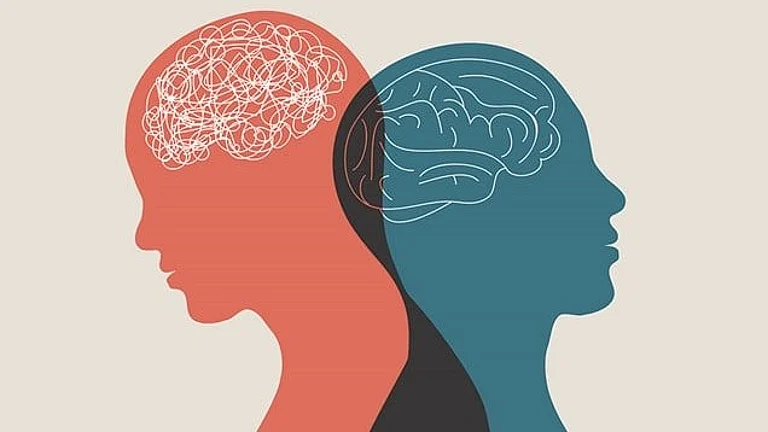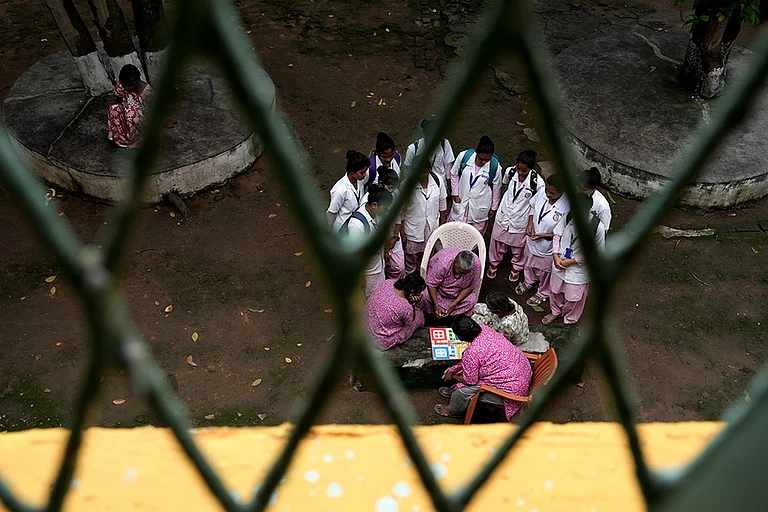
The Maharashtra Prevention of Begging Act, 1960—and similar laws across India—allow police to arrest anyone “wandering aimlessly” or suspected of begging, criminalising poverty instead of addressing it through care and rehabilitation.
Conditions in beggars’ homes are often inhumane, with overcrowding, lack of medical and psychiatric care, and indefinite detentions—leading to deaths.
Despite constitutional guarantees of dignity and liberty, these colonial-era laws continue to punish the poor, homeless, and mentally ill, exposing deep systemic neglect.
“Madam, don’t worry. I will take you to the right place,” said the driver, smiling faintly. A man in his 50s, with the voice of someone who has waited too long for answers. “Three years ago, my father forgot his way home. I looked everywhere. One day I found him at the Beggars’ Home. He had stopped speaking by then.”
There are two buildings at the Beggars’ Home—one for men, one for women. Each gate opens into its own echo chamber. The corridors smell of boiled rice, bleach, and slow decay. The floors are cracked in places; the walls stained with forgotten monsoons. There’s a silence that doesn’t soothe, it crushes. They mutter to themselves, rocking gently like metronomes marking a time no one counts. Most come here with nothing, leave with less. Seven years, two years, indefinite. Forgotten time. Forgotten bodies. Names fade into numeric records. Bunk beds lined in rows, sheets seldom changed, clothes hanging on rusted wires. A tap leaks continuously in one corner—the sound of a slow, unending drip.
“Under the Maharashtra Prevention of Begging Act, 1960, anyone seen ‘wandering aimlessly’ or suspected of ‘begging’ can be arrested without a warrant,” said Sapna Yande, a probation officer. “Many of them come in already dying. Tuberculosis, leprosy, madness, age. Here, they just finish dying.”
The woman leaned forward. “How did Hausabai die?”
Silence.
The Maharashtra Human Rights Commission registered a complaint on June 9, 2022. A custodial death.
“Did she?” replied Chetan Gaikwad, the superintendent who was later transferred when G.K. Arwell took over the position. His voice held no answers—only deflection. He had just replaced Ujwala Hoval in 2024, who had attended every one of the ten court hearings so far. Hearings with no verdict, no headline, no end.
Section 176(1A) of the CrPC demands that any death in custody be investigated by a magistrate. But laws don’t knock on the doors of these places. Files don’t cry. Names fade. And Hausabai’s death sits somewhere in nobody’s job.
“Many of these women should not be here,” said Pallavi Thakkre, a former Koshish volunteer, an initiative by the Tata Institute of Social Sciences. “They’re not criminals. They’re sick. They need therapy, not confinement. And despite everything, many still carry an astonishing capacity for resilience—resisting despair, finding moments of joy, of protest, even here.”
A metal cup clattered to the floor in a far-off cell. No one picked it up.
“Did Hausabai try to...?”
“We don’t know,” she whispered. “Let me think... 2021.”
“She died in 2021?”
Pallavi nodded. Nothing more.
Once arrested, homeless people are brought before a magistrate. For seven days, they are ‘processed’—examined, questioned, searched for family like lost parcels. If found trafficked, they are redirected. If not, they are convicted— not of crime, but of helplessness. One year. Two years. Locked away for being poor.
“If they’re sane, they want to leave,” said Yande. “But by then, sanity has dried up.”
“Was she treated?”
“She was on liquid diet. She didn’t eat solids. Maybe something internal.”
The nurse, Vaishali Bhosle, spoke softly. “There was another woman too—Madhu Nikam, from the Pune Beggars’ Home. She had cancer. We tried… but she died.”
In the ward, you’ll find women staring out from rusted iron grilles, some humming under their breath, some curled into themselves like questions unanswered too long. There are long silences interrupted by sudden laughter or loud sobs. Some talk to walls. Some wait for visitors who never come.
On February 12, 2024, the court convened for the tenth hearing. Nearly two years had passed since Hausabai’s death. There was no witness, no post-mortem report made public, not even a nameplate to remember her by—just a number buried in a forgotten file.
Ujwala Hoval sat quietly in the courtroom. PSI Pradip V. Shinde of Chembur Police Station stared at his phone. The hearing was adjourned—again. But that was in 2024. The designations they held are now outdated. A year later, things have changed. Yet with every bureaucratic reshuffle, the sword of loneliness still looms above their heads.
Outside the centre, the smell of boiled rice and Dettol lingered. The woman—the passenger—tried one last time.
“Can anyone tell me why she died?”
Pallavi didn’t look back. She just said: “There is visible invisibility here. That’s how they disappear— one by one, in front of our open eyes.”
According to government data, over 30,000 individuals are currently housed in beggars’ homes across India. Maharashtra alone operates more than 20 such institutions, many of them overcrowded and opaque. The exact number of people detained for merely being suspected of begging remains unreported.
The condition in which people are brought into beggars’ homes is often nothing short of inhumane. Many arrive in dire need of immediate hospitalisation—with untreated wounds, mental health episodes, chronic illnesses—yet are confined within four walls without any medical intervention. The Maharashtra Prevention of Begging Act, 1960, like similar laws enforced in over twenty states across India, enables the police to arrest individuals suspected of begging, without a warrant.
The proceedings that follow are often arbitrary and volatile. If someone is caught for the first time, merely loitering near a railway station or temple, they can be sentenced to one or two years in a beggars’ home. Inside, they are not treated by professionals but often by convicts assigned to caregiving roles. Medical care is scarce, and psychiatric help is nearly non-existent.
One year of unidentified, untreated mental illness can worsen conditions, making the path back to stability increasingly steep—though recovery always remains possible with the right support.
And when the same individual is arrested a second time, the punishment is harsher: three to ten years of institutional custody. A life sentenced not for a crime, but for being visibly poor.
“I can guarantee that some beggars’ homes house more people with mental health conditions than actual psychiatric hospitals,” says Mohammad Tarique, the founder of the Koshish Foundation and founder-director of Sam-Haq Project.
It is not just those who engage in begging who suffer under these laws—it is the working homeless, the abandoned elderly, and people with mental illness who become the worst victims. “This law doesn’t resolve homelessness. It criminalises helplessness. It punishes people simply for existing without support,” Tarique adds.
Clause 3 of the Maharashtra Prevention of Begging Act permits the indefinite remand of a person suffering from leprosy, mental illness, or any lifelong disability. Once arrested, such individuals can be detained for years, often without adequate treatment or review. They vanish into the system—into forgotten homes—without any inquiry into whether they deserve to be there or need care elsewhere.
Shockingly, the Supreme Court’s guidelines for improving conditions in mental health institutions do not apply to beggars’ homes. These facilities remain outside the purview of such reforms, even though they house thousands with severe psychological distress.
“The Beggars Act is not a piece of welfare legislation—it’s a probe. A dangerous probe that does not seek to rehabilitate, but to remove. To erase,” says Tarique.
In May 2018, a so-called “beggar-free” drive was launched in Nashik, spearheaded by the city police on orders from the Assistant Commissioner. The goal? To “cleanse” the streets of people perceived to be beggars. But what unfolded blurred the line between law enforcement and human rights violation.
On May 7, 2018, 30 women and 19 children were taken into custody from the streets of Nashik—not for begging, but for selling goods to earn a living. They weren’t informed of the charges. No one told them they were being arrested under the Maharashtra Prevention of Begging Act. They weren’t read their rights. No legal representation was offered. And crucially, no inquiry was conducted to determine whether these women were actually begging.
That same day, a court order was passed for their detention. None of them knew what it meant. Without warning, the women and children were transferred from Nashik to the Receiving Centre in Yerwada, Pune. Their families weren’t informed. For three days, they remained in Yerwada, unaware of what was happening, and then, on May 10, they were moved again—to a certified institution in Chembur, Mumbai, where they were held for the remainder of their sentence.
Many of them were daily-wage earners, single mothers, or elderly women trying to survive by selling small items on footpaths. Their arrest and prolonged detention left them not only traumatised but also robbed of their only means of livelihood.
While hearing a petition against this detention, Justice Sadhana Jadhav made a crucial distinction: this was not a plea to decriminalise begging. It was, at its heart, a plea to uphold due process.
“The least that is expected from the concerned authorities is to follow due process of law,” the court observed.
It was a reminder that the rule of law applies even to the most invisible citizens—even to those dismissed as vagrants, addicts, or mentally ill.
The court stressed that a person cannot be branded as a beggar casually, nor can their liberty be taken away without the procedure established by law. Every individual— regardless of education, class, or legal literacy—has the right to know the grounds on which they are indicted, and the right to defend themselves. Anything less, the court warned, is a violation of natural justice.
In this case, most of the women detained could not read or write and had no access to legal representation. No advocate stood beside them as they were processed and packed off to certified institutions in Pune—a euphemism for detention homes, where the conditions, as alleged, were “pathetic, unhygienic, and harmful.”
Though the State filed an affidavit denying these allegations, the Court’s concern was palpable. Even as it acknowledged its limitations in issuing broader directions, the judgment left no ambiguity about the failure of the system.
The result: the Court set aside the impugned order dated May 7, 2018, passed by the Chief Judicial Magistrate of Nashik. The detention order against the women—who had been quietly moved from Nashik to Yerwada and later to Chembur—was annulled.
Many other women at the Beggars’ Home end up there by what can only be described as an accident of circumstance— displaced by poverty, violence, mental illness, or a momentary lapse in memory that spirals into disappearance.
Juhi was one of them.
When she arrived, she was a shadow of herself—silent, withdrawn, unable to eat, and unable to recall who she was or where she had come from. Her mind, fractured by trauma, had blocked out all traces of identity. Staff at Koshish suspected she was suffering from dissociative amnesia, likely triggered by prolonged psychological distress and possible abuse.
Over months of trauma-informed counselling, routine mental health care, and gentle rehabilitation efforts, Juhi began to emerge from the fog. Memory came back in fragments— names, landscapes, half-formed images of a village in Bihar. Slowly, she began to speak. Through these scattered recollections, Koshish traced her family.
But when they were contacted, her family—perhaps out of shame, fear, or caste stigma — refused to take her back. Juhi belonged to the Musahar community, one of India’s most marginalised Dalit castes, often denied not just land or education, but even the right to grieve their own.
Juhi was eventually transferred to a government-run shelter home in Bihar, where institutional life once again enveloped her. In April 2020, she died—presumably of COVID-19. Delayed testing and limited medical oversight left her cause of death officially unconfirmed, much like the life she had led: undocumented, unresolved, unseen.
India inherited this punitive legacy.
Post-Independence, the Indian Constitution promised its citizens dignity and equality. But while the rhetoric changed, the structures of colonial control remained. The Bombay Prevention of Begging Act, 1959 (BPBA)—adopted by over 20 states and union territories—embodies this contradiction. Though it claims to curb public nuisance, in practice it criminalises the poor, the homeless, the disabled, and the unemployed. The crime, under this law, is not an act—it is an identity.
“It’s not rule of law,” said a legal aid volunteer from Koshish, “It’s rule by law—targeting the vulnerable through bureaucratic coercion.”
The BPBA directly contravenes multiple constitutional safeguards, notably Article 19(1)(a), which guarantees freedom of expression, and Article 21, which affirms the right to life and personal liberty. Under the guise of maintaining order, the Act enables authorities to arrest individuals on mere suspicion of begging and send them to detention centres known as “beggars’ homes”—often for years, sometimes indefinitely. If someone is deemed “incurably helpless,” they can be confined for life.
This is in direct contradiction to Article 38 of the Constitution, which mandates the state to promote the welfare of all citizens, and Entry 9 of the State List, which makes it the state’s responsibility to care for the disabled and the unemployed. Yet, in place of support, what the marginalised receive is confinement. The very people most in need of care are penalised for their vulnerability.
The contradiction becomes painfully clear when one hears the stories from the ground.
Megha, who sells handmade toys at Mumbai’s traffic signals, was once picked up by the police and labelled a beggar. “We don’t want comforts,” she said. “Just to live. Is that a crime?”
Madhav’s son was arrested for drinking water outside a temple. Since then, he has been trapped in the system, held in custody, caught in a legal limbo with no end in sight.
Santosh, a visually impaired peanut vendor, shared his daily struggle: “I can’t see—but the police can’t see that I work, not beg. What law is this?”
These stories are not outliers. They reflect systemic failures that conflate poverty with criminality. What the state calls law enforcement, the marginalised experience as daily humiliation, exclusion, and the criminalisation of their very survival.
The justification often used for begging laws is that they deter organised crime or protect public spaces from nuisance. But in decades of enforcement, the BPBA has yielded almost no evidence of large-scale begging rackets. Instead, the machinery of the state comes down hardest on those least able to defend themselves: people with disabilities, the elderly, abandoned women, those living with mental illness or substance dependencies, and members of Denotified, Nomadic and Semi-Nomadic Tribes.
For these communities—whose traditional livelihoods such as street performances, fortune telling, or snake charming have been outlawed—the punishment is twofold. First, they are stripped of their means to earn a living. Then, for attempting to survive through any visible means, they are arrested under begging laws. The legal system makes them disappear—out of view and out of mind.
This is not welfare—it is optics. The poor are removed from public spaces during international summits and political events, not to be helped, but to be hidden. They are rendered invisible by force, their lives sanitised from the city’s surface.
In a neo-liberal economy where income inequality is deepening, where rural distress forces mass migration into overcrowded cities, and where caste, disability, and gender discrimination continue to push many into the margins, the law offers no safety net—only a snare.
A 2023 study conducted by Koshish in Bengaluru found that begging is rarely a choice. It is the consequence of broken systems—failures of public healthcare, housing, social support, and employment. But the image of the beggar as a threat is carefully constructed, to legitimise what is essentially state-sanctioned violence against the poor.
“This is legalised apartheid,” said Tarique. “Not against race—but against poverty.”
In one of the beggars’ homes visited during the study, an old man with cataracts in both eyes sat curled in a corner, clutching a broken comb. He had no name, no relatives, and no conviction. He had simply been “picked up” from the footpath near a railway station. For five years, he had been waiting—for a hearing, a transfer, or maybe just to be noticed. Around him, the walls were high and the light was dim. No one remembered when he arrived. No one knew when—or if—he would leave.



































